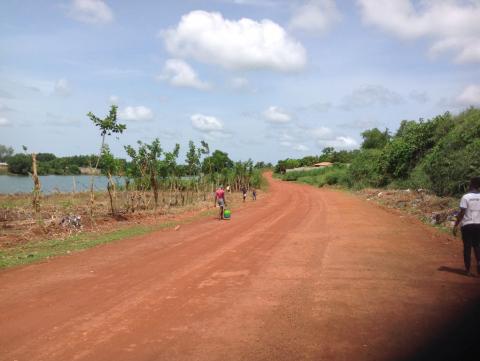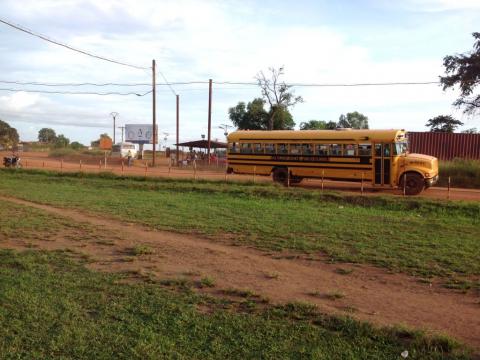Rutile, The Dusty Mining Town
By Kemo Cham
The dusty nature of the road linking Moyamba Junction to Rutile adds a discomforting touch to an awful experience for travelers.
Rutile is an informal reference to a group of communities within a geographical area endowed with the titanium mineral of the same name - just another Sierra Leonean community standing atop abundance of wealth, yet the people struggle in deprivation.
The 76km (46miles) stretch of road directly links two of the four districts that make up the southern region of Sierra Leone – Moyamba and Bonthe - and it serves as a by-pass to the other two – Bo and Pujehun.
Rutile partly covers Bonthe and partly Moyamba and, despite being home to a Class A mining company - Sierra Rutile Limited, with over 30 years of mining history - the community remains one of the poorest and least developed parts of the country.
Moriba Town, the most prominent business center in Rutile, is a regrettably perfect illustration of this sad reality. Even in November, when the rains were still pouring, the dusty nature of the township provided an insight into what life would be like during the dry season proper.
The movement of one vehicle set up a thick cloud of dusts that hanged in the air for between two and three minutes, before another vehicle passed, leaving behind it another cloud.
“We are constantly in this condition. We feel sick always,” lamented Fatmata Jalloh, who sells shoes and cosmetics at the Lorry Park. She said she regularly buys medication for common cold.
Most of the vehicles that ply the roads within this township carry the logo of Sierra Rutile. Men, in the trademark brightly colored yellow and black strips jackets, adorned with the company’s label, can be seen criss-crossing the streets.
Rutile (the mineral) is the most common and stable form of titanium dioxide found in nature and it has multiple uses of huge economic benefits. As a metal, it is used for high tech alloys because of its light weight, high strength and resistance to corrosion. In powder form, it is widely used as pigment for lending whiteness and opacity. Rutile is also thought to be of major importance to the gemstone market.
Sierra Leone ranks third on the list of Rutile producing countries with an annual production of over 600, 000 metric tonnes in 2010, behind Australia at the top with an annual production of 2.8 million metric tonnes and South Africa with an annual production of 1.3 million metric tonnes the same year, according to the Maps of the World.
According to the National Minerals Agency (NMA), Sierra Leone has the largest natural rutile reserve in the world. Information on the agency’s website indicates that since the mineral was first discovered in the country in 1954 in the gravels of the Lanti River in the Southern Province, four groups of deposits have been identified distributed across four districts: Bonthe, Bo, Moyamba and Kambia.
Sierra Rutile Limited, formerly a subsidiary of the British-owned Titanium Resources Group (in 2016, the Australian sand miner Illuka acquired Sierra Rutile for 215 million Pound Sterling), primarily holds leases for mining rutile in the country since its formation in 1971. These leases cover a land area of 580 km2, comprising some 19 identified deposits.
Sierra Rutile’s concessions presently span five chiefdoms in two districts: Imperi and Jong chiefdoms in Bothe; Lower Banta, Upper Banta, and Bagruwa chiefdoms in Moyamba.
Imperi is the most important among them as it hosts the company’s main mine sites. And because of this, say activists, this chiefdom is also the most impacted both in terms of environmental destruction and human rights issues arising from the miner’s activities.
Moriba Town and nearby Mogbwemo are the two largest and most prominent towns in the Imperi Chiefdom. After over three decades of mining, the people in these communities can only dream of better days.
Dozens of houses have been destroyed and communities moved over the last three decades, to make way for the ever expanding operation of Sierra Rutile. This has created many communities with grievances over issues relating to land grabbing, crop compensation, and royalty payments.
Lack of transparency
Unlike in places like Kono in the Eastern Province, where there is a high level of awareness about what the main mineral, diamonds, are and the people are directly involved in its exploration, in Rutile the people only know the name of the mineral removed from their land. And this, said Augusta Nuwomah, a civil society activist based in Mogbwemo, means that there is little chance for transparency and even lesser chance for the people to benefit from their lands.
“If what is coming from your land you can’t see it, how will you know that it is not benefitting you?” she said.
Augusta runs the Women’s Initiative Forum for Empowerment in Extractive (WIFEE), which is one of a growing crop of community based organizations in Rutile that are raising awareness among mining communities. She said the lack of awareness had led to serious tension between affected communities and the company in the past. Locals, she noted, were not properly informed about their lands before they were taken by the company. Consequently, protests had become a commonplace in Rutile, she said.
Through constant engagement, activists like Augusta have helped to sensitize the populace, to the point that tension between community people and the company has lessened over the last few years.
But she warned that there is high potential for trouble in the future, as the rise in awareness level puts the company’s operation into tighter scrutiny, especially in light of the widespread poverty among the masses.
Already there is a strong sense of this among many residents who lament the lack of amenities like electricity and pipe-borne water throughout the Rutile community.
Residents of Rutile travel about 35 miles to Serabu in Moyamba District when they have serious health issues that require a specialist’s attention, because the health posts located in each of these communities aren’t equipped enough.
Sierra Rutile runs a state of the earth health center, located at a place called Plant Site, between Moriba Town and Mogbwemo. But it is open to only its staff and their immediate family.
Along the streets of Mogbwemo, electricity lines pass above houses with no light, onto a plush uphill estate called Mobinbi, which houses the company’s executives and foreign consultants.
In addition to all this, the people of Rutile have had to put up with environmental issues emanating from the company’s operations, like the mined out pits, which are scattered all over the place and have become death trap, particularly for children and the aged.
One of the most affected villages, Gundama, which is located along the main route that leads from the mine site to the company’s depository, is almost surrounded by these dangerous water bodies the locals call dams or artificial lakes.
Lightening is a common occurrence in Rutile, and activists believe there is a connection between some of the equipment Sierra Rutile uses in its operations. Residents say every year there is at least one report of destruction due to lightening, with loss of lives.
Opposite the Kahekay Maternity Community Health Post in Lungi Gangama, a small community just outside Mogbwemo, stands an abandoned compound. It used to be home to a family of five. According to activists and neighbors, in 2017 lightning struck the thatched house and rendered the entire family immobilized for days. Luckily they survived.
Student protests
Moriba Town is home to the Impere Secondary School. Founded in 1970, it is the biggest secondary school in the whole chiefdom.
Science teacher, Father Roland Okoro’s struggle to provide a proper science lab for his students provides a perfect illustration of how the people of Rutile are suffering in the midst of abundance.
It was already dark when we arrived at the school. With the aid of the deem lights from mobile phones, the Catholic priest and educator struggled to show us the dilapidated state of the lab. He wanted the government to help equip it, in line with President Julius Maada Bio’s highly publicized Science and Technology agenda.
Because of the heat in the lab, some of the chemicals which should be in liquid form had long since become solidified. Mr Okoro said they have had to borrow basic apparatus from schools in nearby Bo District to be able to conduct examinations involving practical work.
Some business oriented residents of Rutile have taken advantage of the opportunity offered by the lack of electricity in the town and bought generators which provide power to anyone who can afford to pay a monthly fee. Subscribers complain that the unregulated scheme has become a means of exploitation.
Because of the high cost of connection, Impere SS can only afford to connect a few of its buildings: the administrative block and the teachers’ quarters. And because they can no longer provide light throughout the school compound, the school has had to discontinue night classes for examination students.
Mr Robert Nyama, Principal of the school, said several appeals for help from Sierra Rutile have fell on deaf ears.
“We are just here [and] people think that all is well for us. A school like this people will think that the company is supporting us. But it is not. You will make a requisition and they will not look at you,” he lamented.
But there are other concerns for the school’s management - recurrent protests by students who are angry with the company for another reason.
A notable characteristic of the Rutile community is the huge, unpaved, red dirt roads that adjoin the neighboring communities.
To create unrestricted access between its mine site and the depository, Sierra Rutile has constructed many roads and diverted many others. The roads are notably wide to accommodate the company’s huge haulage trucks.
Due to the nature of these haulage trucks, it is not in the company’s interest to pave any of its roads. Therefore there is not a single paved road in the whole of Rutile. Consequently, communities like Gundama, which are located along these routes that lead from the mine site to the depository, are constantly covered in dust.
Also, because of Sierra Rutile’s relocation programs and diversions created for easy access of the haulage site, in some communities people now have to travel longer distances to places that previously took a shorter time to cover – like hospitals, markets and, for the children, school.
This has particularly affected school children in the relocated communities, who organized themselves under the ‘Mining Area Concerned Students Association.’ Their president, Mamadou Allieu Sowe, explained that many of them travel to school from far away communities, like Mosenesie, Mokepai, and Mokanji. The closest among these to Impere SS is Mokepai, which is about three miles distance. The farthest, Mokanji, is about 10 miles away.
“When we come to school, in our uniforms, the company vehicles pass us and raise dust on us and dirty our uniforms. When we beg them for lift, even when there is no one in the vehicles, they do not stop,” narrated Mamadou, who was the outgoing senior prefect of the school.
He said they had asked the company to help them with school buses but they were told that the company is not responsible for that because it gives money to their traditional leaders.
A spokesman for Sierra Rutile admitted that they were aware of the discomfort their operations caused the local community, like dust. But, said Osman Lahai, Community Affairs Officer of the company, they endeavor to minimize the discomfort. He said in addition to pumping water on the road three times in a day, the company imposed a speed limit on all is vehicles as a way of limiting the dust their movement generates.
Lahai added that as far as the roads are concerned, the company only has responsibility to its haulage route. He pointed out that they paved the roads running through the communities as a goodwill gesture.
According to the company’s spokesman, besides fulfilling its responsibilities as required by law, Sierra Rutile seeks to meet all its corporate social responsibilities through various financial contributions made through prescribed community structures. In responding to access to its clinic, it said the clinic’s capacity is such that it cannot service the entire community, and therefore they have prioritises their workers and their immediate dependents.
Promises upon promises
According to Sowe, he had written several letters to all three Paramount chiefs of chiefdoms that fall within the company’s concession: PC John Gibao Russel Nyama, PC Tommy Moilaylay Jomla, and PC Hawa Kpanabom about their predicaments. He said all they have gotten in response were promises upon promises.
“I am in Moriba Town, but some of my colleagues come from very far away, some 10 miles away. When they come they are tired. They also come late to class,” stressed Mr Sowe.
Consequently, the students have resorted to recurrent strike. They usually block major routes plied by the company’s haulage trucks. The Mosenesie Juncton, a popular intersection that links that part of Bonthe to Bo, Pujehun and Moyamba, has become the scene of recurrent student protests. The last strike happened two weeks before this interview with the student president.
Sowe had just come from the internet cafe where he went to type a letter addressed to three separate government ministers in Freetown: Mines; Transportation, and Education. He wanted to inform them about their plight.
As a final year student at the Impere SS, Sowe was expecting to be enrolled into a tertiary institution, but he had no idea where to go to. He said their other plea to the government ministers was for them to consider establishing a technical institution in Rutile where they can be trained so that they can be employed by the company.
“At the moment, when we finish here, there is nothing we can do,” he said.
While the younger generation dreams of jobs with the company, those already working there are struggling to fit in, amidst endless complaints of labor violations and unfair treatments.
Samuel Lamin Suluku recently resigned from Sierra Rutile and returned to his former job as a teacher. He wouldn’t say exactly why he quitted the company every youth in the area was dreaming to work for, except that it’s “for personal reasons.”
But Mr Suluku, who hails from nearby Bagruwa Chiefdom, represents the many disgruntled voices of the youths of Rutile. He said the only employment opportunities preserved for indigenes were casual work.
“There are qualified people from this community. They don’t employ us. They’d rather take people from elsewhere. They marginalize us,” he said.
Sierra Rutile says it offers equal opportunities for employment, with priority given to indigenes for certain jobs.
Nonetheless, almost every youth you talk with in Rutile, they will complain about this. And they all lay the blame on the feet of the local authorities for turning a blind eye.
“Nothing is being done so that when mining will have faded out, the people can embark on something meaningful for their lives,” said Suluku.
“The government,” he added, “needs to come and do thorough investigations as to how the mining is taking place and to tell these miners that we are suffering directly and for them to give us priority when it comes to employment.”
This report was done in collaboration with the National Advocacy Coalition on Extractive and the Open Society Initiative for West Africa.
© 2019 Politico Online










